I am trying to implement openCV method warpPerspective() from scratch, I made the code below, it can handle shifts in y and x but, when I pass homography matrix from findHomography() to the function I made it always gives blank image compared to warpPerspective() output.
I followed this definition to find the new locations of the pixels:
s*x' h1 h2 h3 x
s*y' = h4 h5 h6 * y
s h7 h8 1 1
my mapping works on simple shift like { 1, 0.5,-51,0,1,50,0,0,1}

but when matrix is like:
[1.0340946, 0.032195676, -6.419126;
0.00302419, 1.0487343, -96.520393;
3.7013847e-06, 0.00010837225, 1]
the output is like this:

my implementation: -Given H, and image A, -Find new locations of pixels in A and save them in TransArry.where the index of the array is the linearized index of A. -Remap pixels of A into tranImg.
Mat transform(Mat A, Mat H)
{
// allocate array of all locations
int Numrows = A.rows;
int Numcols = A.cols;
int channels = A.channels();
cout << "rows " << Numrows << "col " << Numcols << "channels " << channels <<endl;
int size = Numrows*Numcols;
int MaxX,MaxY = -1000;
int MinX,MinY = 1000;
int *TransArry = (int *)malloc(sizeof(int)*size);
int Idx;
int homeX=Idx % Numcols;
int homeY=Idx / Numcols;
cout << H << endl;
waitKey();
for (Idx=0; Idx < size; ++Idx ){
homeX=Idx % Numcols;
homeY=Idx / Numcols;
float x = (H.at<float>(0,0) * (homeX)) +( H.at<float>(0,1) * (homeY)) + ( H.at<float>(0,2) * 1) ;
float y = (H.at<float>(1,0) * (homeX)) +( H.at<float>(1,1) * (homeY)) + ( H.at<float>(1,2) * 1) ;
float s = (H.at<float>(2,0) * (homeX)) +( H.at<float>(2,1) * (homeY)) + ( H.at<float>(2,2) * 1) ;
cout << " x = " << x << " y= " << y << " s= " << s;
x = (x/s);
y = y/s;
// for the first col in TransMatrix
if (homeX ==0){
if (x > MaxX) MaxX = x;
if (x < MinX) MinX = x;
}
//for thee first row in TransMatrix
if (homeY ==0){
if (y > MaxY) MaxY = y;
if (y < MinY) MinY = y;
}
if((y)>=A.rows || (y)<0 || (x)>=A.cols || (x)<0){
TransArry[Idx] = -1;
cout << "x= " << x << "y= "<< y << endl;
}else{
TransArry[Idx] = (y * Numcols + x);
}
//cout << Numcols << endl;
cout << "New index of " << Idx << "is " << TransArry[Idx] << endl;
}
Mat tranImg ;
A.copyTo(tranImg);
tranImg = tranImg - tranImg;
cout << "Rows" << tranImg.rows << "cols" << tranImg.cols << "cha" << A.channels() << endl;
waitKey();
// Remap Image
for (Idx=0; Idx < size; Idx ++ ){
homeX=Idx % Numcols;
homeY=Idx / Numcols;
//tranImg.at<uchar>(homeY, homeX) =0;
if(TransArry[Idx] != -1){
//cout << "Index " << Idx << "Passed " << endl;
int newhomeX=TransArry[Idx] % Numcols; // Col ID
int newhomeY=TransArry[Idx] / Numcols; // Row ID
cout << "Index is " << Idx << endl;
cout << "HomeX is " << homeX << " and HomeY is " << homeY << endl;
cout << "New Index is " << TransArry[Idx] << endl;
cout << "New HomeX is " << newhomeX << " and New HomeY is " << newhomeY << endl;
cout << "*****************************************"<< endl;
// if (!(Idx%100)) sleep(20);
tranImg.at<uchar>(newhomeY, (newhomeX*channels)) = A.at<uchar>(homeY, homeX*channels);
if(channels>1)
tranImg.at<uchar>(newhomeY, newhomeX*channels+1) = A.at<uchar>(homeY, homeX*channels+1);
if(channels>2)
tranImg.at<uchar>(newhomeY, newhomeX*channels+2) = A.at<uchar>(homeY, homeX*channels+2);
// if (!(Idx%100)){
// imshow("inside", tranImg);
// waitKey(1);
// }
}
}
//cout << tranImg << endl;
return tranImg;
}
H is calaculated and verified.
So, is there a problem in the way I access the matrices H and A?